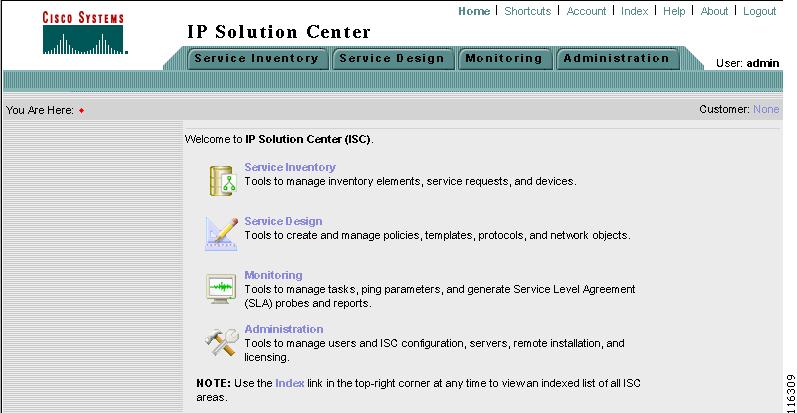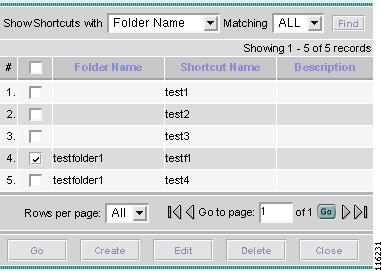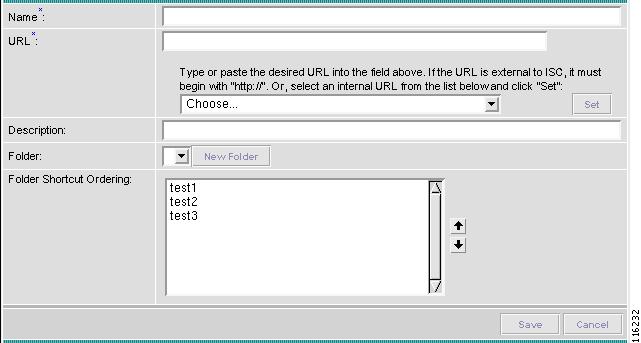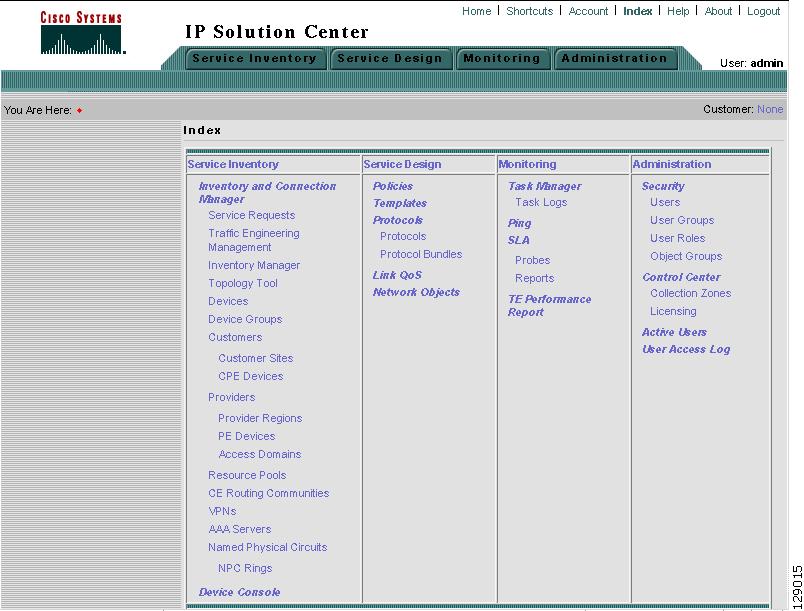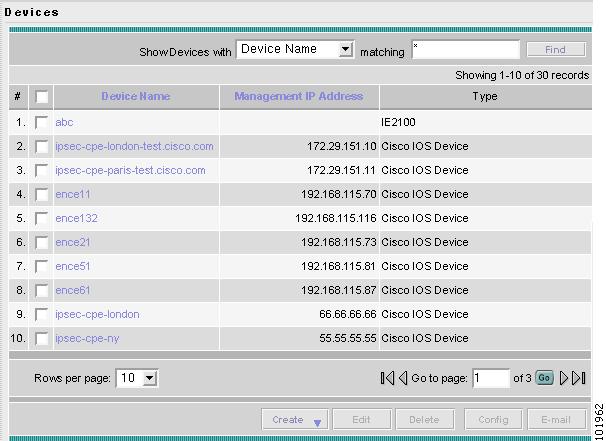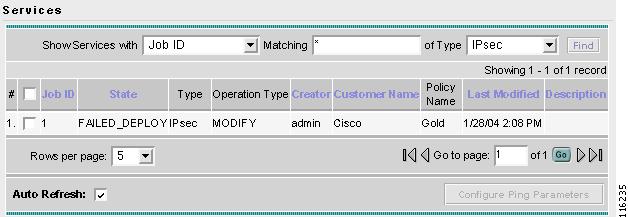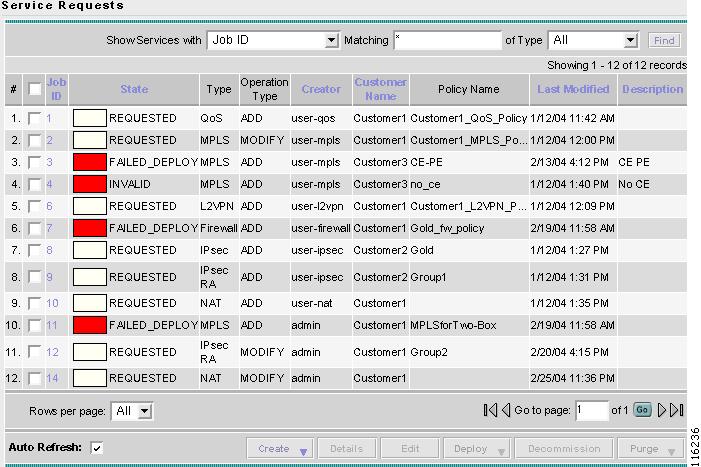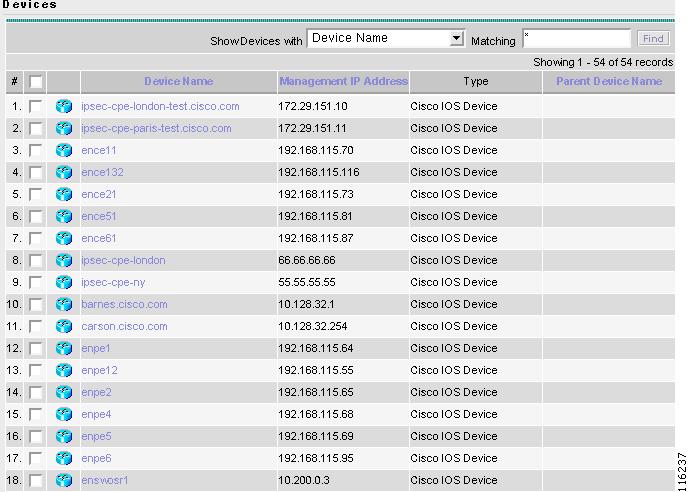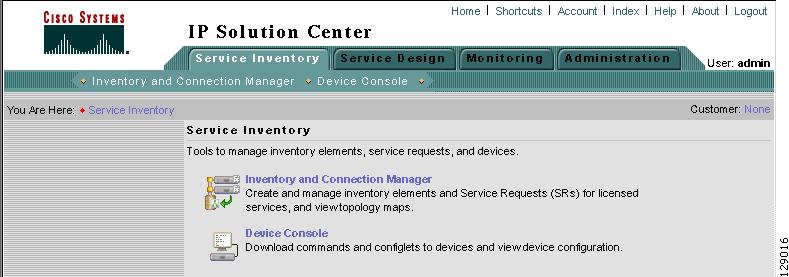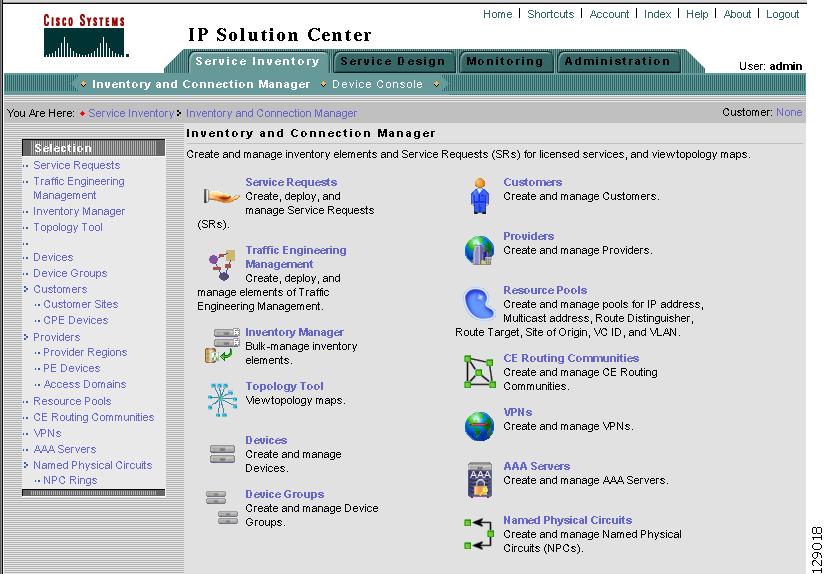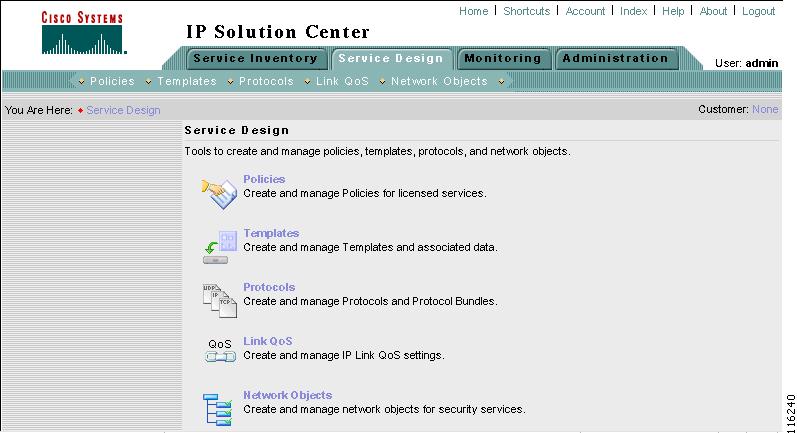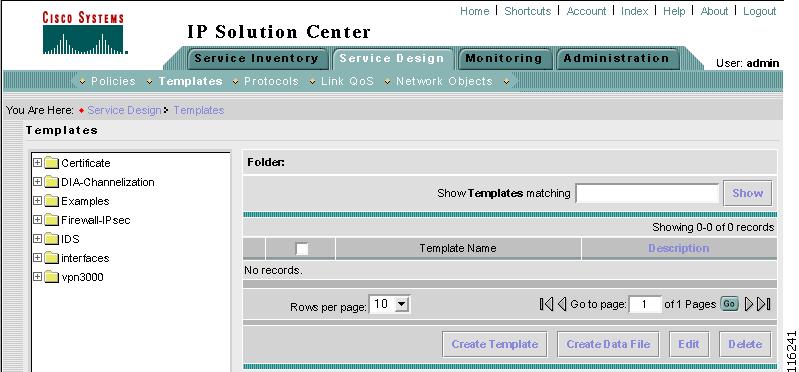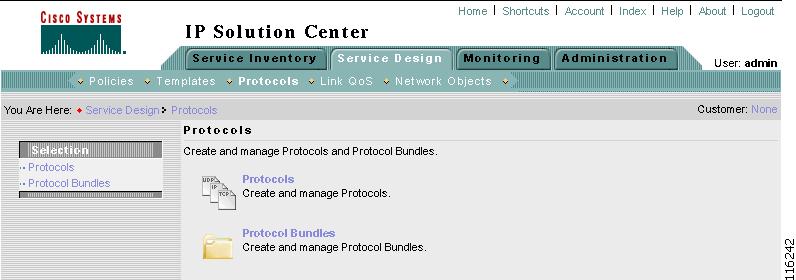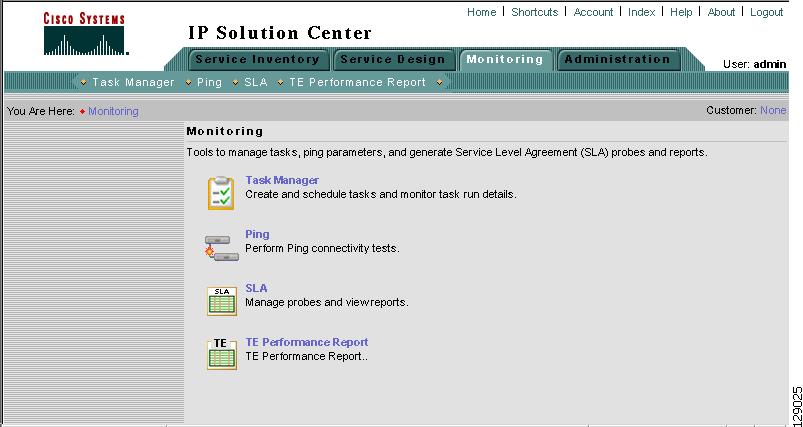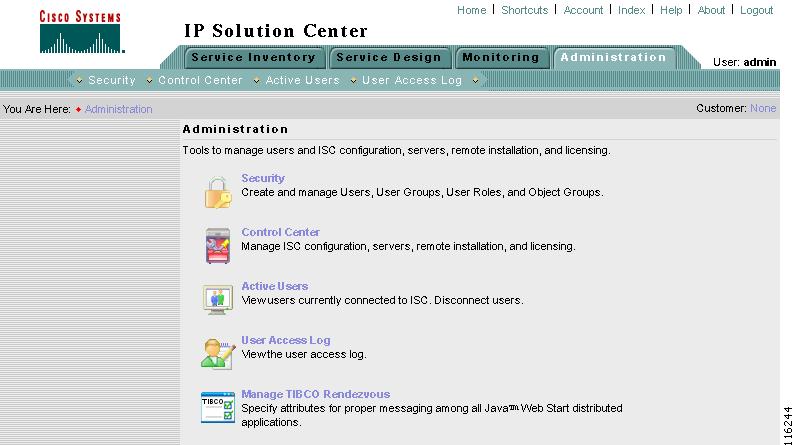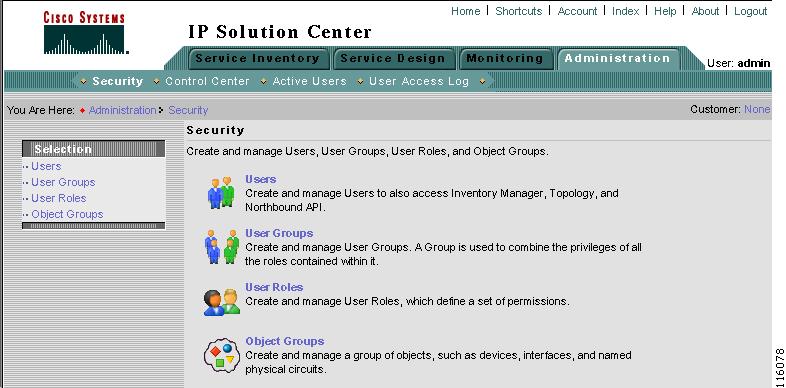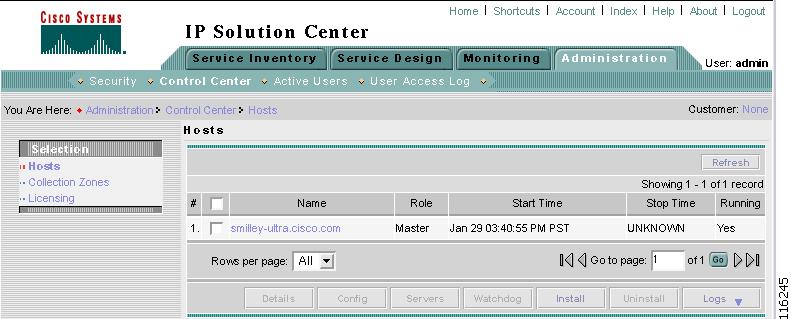

-
Cisco IP Solution Center Infrastructure Reference, 4.0
-
Index
-
About This Guide
-
Getting Started
-
WatchDog Commands
-
Service Inventory > Inventory and Connection Manager
-
Service Inventory > Inventory and Connection Manager > Inventory Manager
-
Service Inventory > Device Console
-
Service Design
-
Monitoring
-
Administration
-
Cisco CNS IE2100 Appliances
-
Property Settings
-
Glossary
-
Table Of Contents
Getting Started
This chapter provides information about how to get started to use Cisco IP Solution Center (ISC) and gives a structural overview of this manual. The information is in the following categories:
System Recommendations
The system recommendations and requirements are listed in Chapter 1, "System Recommendations" of Cisco IP Solution Center Installation Guide, 4.0. The recommendation is to thoroughly review this list before even planning your installation, to be sure that you have all the hardware and software you must successfully install.
CautionThere is no identified and supported way to upgrade from ISC 3.0 to ISC 4.0. To upgrade from ISC 3.0 to ISC 4.0, you must contact ISC Marketing, e-mail: isc-mktg@cisco.com.
Introduction
Cisco IP Solution Center, 4.0 (ISC 4.0) is a follow-on release to Cisco IP Solution Center, 3.2 (ISC 3.2), with the exceptions listed in Cisco IP Solution Center Release Notes, 4.0.
This manual lists many features that are common among all the applications, which are sold and licensed separately. The applications and their respective User Guides reference this document for setup steps necessary before creating a policy and then a service request specific to the application.
The Full Menus Graphical User Interface (GUI), is separated into the following large sections (tabs):
•
Service Inventory
•
Service Design
•
Monitoring
•
Administration
The remaining sections in this chapter explain the sections and subsections of this manual that explain the functionality available from these tabs.
Structural Overview
After you log into Cisco IP Solution Center (ISC), the first window to appear is the Home window, as shown in Figure 1-1, "Home Window."
Figure 1-1 Home Window
Note
The tabs and the choices navigating within the tabs that appear depend on the user permission, explained in "Administration"(Administration > Security > User Roles). The choices shown in this manual are for all permissions (admin).
This overview includes the following sections:
Product Category Tabs
The organization of this manual is based on the tabs shown in Figure 1-1, "Home Window." Click either the specific tab or the name in the data pane:
•
Service Inventory An overview is given in the "Service Inventory" section and detailed information is given in "Service Inventory > Inventory and Connection Manager," Chapter 4, "Service Inventory > Inventory and Connection Manager > Inventory Manager," and "Service Inventory > Device Console."
•
Service Design An overview is given in the "Service Design" section and detailed information is given in Chapter 6, "Service Design."
•
Monitoring An overview is given in the "Monitoring" section and detailed information is given in "Monitoring."
•
Administration An overview is given in the "Administration" section and detailed information is given in "Administration."
Links
In the upper right-hand corner of the Home window (Figure 1-1), additional links appear that function as follows:
•
Home
•
Help
On the far right of the You are Here: line on the Home window (Figure 1-1), is the name of a Customer Context, which is explained in the "Customer" section.
Home
When you click Home, you always return to the first window to appear, as shown in Figure 1-1, "Home Window."
Shortcuts
When you click Shortcuts, you can define shortcuts to help quickly navigate to day to day operations. In addition, by grouping these shortcuts together into folders, you can create work flows specific to your operating environment. Shortcuts are further explained in the following steps:
Step 1
After you click Shortcuts, you receive a window as shown in Figure 1-2, "ISC Shortcuts."
Figure 1-2 ISC Shortcuts
Step 2
To create a shortcut, click the Create button in Figure 1-2 and you receive a window as shown in Figure 1-3, "New ISC Shortcut."
Figure 1-3 New ISC Shortcut
Step 3
Fill in the required Name and URL (you can type in the URL, in which case if it is external to ISC, you must start the URL name with http://, or you can click the drop-down button and choose a path internal to ISC and then click the Set button) and optionally the Description, Folder, and Folder Shortcut Ordering. Then click Save.
Step 4
You return to Figure 1-2 and can repeat Step 2 and Step 3 to Create more shortcuts or you can select a shortcut to proceed to Go, select a shortcut to Edit, select one or more shortcuts to Delete, or select Close.
Step 5
Any time you want to go directly to a URL, you can click Shortcuts on the Home page and from Figure 1-2 select the shortcut of your choice and click Go.
Account
When you click Account, you can change your password without the SysAdmin or UserAdmin privileges. This allows you to edit the user profile, including changing the password.
Index
When you click Index, you receive an overall picture of all choices from which you can click and jump to, as shown in Figure 1-4, "Index of all Choices."
Figure 1-4 Index of all Choices
Help
When you click Help, you receive a pointer to the documentation set once it is on CCO.
About
When you click About, you receive the product name and version.
Logout
When you click Logout, you log out of the product.
Customer
On the far right of the You are Here line of the Home page is Customer: followed by None (default) or a customer name. This is referred to as Customer Context. The advantage of Customer Context is to focus only on information for a specified customer. Set the Customer Context, as follows:
Step 1
Click on the name after Customer: on the far right of the line that starts with You are Here. The default is None. The window shown in Figure 1-5, "Customer Context," appears.
Figure 1-5 Customer Context
Step 2
Click the Select button and you receive a list of all the currently created customers.
Step 3
Select the customer for which you want information and click Save.
Step 4
Figure 1-5, "Customer Context," reappears with the name of the selected customer. Click Save or highlight the customer name and click Clear to reset the customer for which you want information.
Step 5
The customer you chose now appears after Customer: on the Home window and it is the only customer for which information appears.
Step 6
You can reset the Customer Context by clearing and reselecting.
Common GUI Components
GUI components that are common on many windows are as follows:
Filters
At the top of many windows you can filter information that appears in the window. As shown in Figure 1-6, "Example of Filtering, Rows per Page, and Changing Pages," you can click the drop-down menu for categories, then in the matching field enter the search criteria, using * if you wish to indicate anything will be a match (you can enter only * or you can place * before other characters, in the middle of other characters, at the end of other characters, or in multiple locations), and click Find. In some cases you might also have a field after the matching field from which you can select or enter more specifics for your Find.
Rows per Page
In the bottom left corner of many windows, as shown in Figure 1-6, "Example of Filtering, Rows per Page, and Changing Pages," you can change the number of rows shown on this window in Rows per page. Click the drop-down menu and you can select 5, 10, 20, 30, 40, or All.
Note
When you navigate Service Inventory > Inventory and Connection Manager > Service Requests, if the number of service requests stored in the repository exceeds 3000, then for the Rows per page drop-down, do not choose All.
Go To Page
In the bottom right corner of many windows, as shown in Figure 1-6, "Example of Filtering, Rows per Page, and Changing Pages," there is Go to page field of y. In the field, you can enter the page to which you want to navigate and then click the Go button to get there. The y indicates the last page for this topic. Another way to navigate to a specific page is to use the arrows. You can click the > arrow to navigate to the next page or the furthest arrow to the right >| to navigate to the last page. You can click the < arrow to navigate to the previous page or the furthest arrow to the left |< to navigate to the first page.
Figure 1-6 Example of Filtering, Rows per Page, and Changing Pages
Auto Refresh
At the bottom left corner of several windows, there is a check box used to enable or disable the Auto Refresh feature, as shown in Figure 1-7, "Example of Auto Refresh." Checking this box causes the screen and its data to refresh every n milliseconds. The amount of time between refresh cycles can be set in the DCPL property: GUI.srRefreshRate. By default, the Auto Refresh feature is enabled to 30000 milliseconds.
Figure 1-7 Example of Auto Refresh
Color Coding
In the Service Request table, the Task table, and the Device table, the colors you see indicate the state of the items, as shown in Figure 1-8, "Colors as Identifiers."
In the Service Request table, the states have the following colors:
•
BROKEN is bright yellow
•
CLOSED is no color
•
DEPLOYED is bright green
•
FAILED AUDIT is bright yellow
•
FAILED DEPLOY is bright red
•
FUNCTIONAL is bright green
•
INVALID is bright red
•
LOST is bright yellow
•
PENDING is bright green
•
REQUESTED is cream
•
WAIT DEPLOYED is cream
In the Task table, the states have the following colors:
•
ABORTED is orange
•
RUNNING is bright green
•
WAITING_TO_RUN is cream
•
errors is bright red
•
successfully is bright green
•
warnings is cyan
In the devices table, the states have the following colors:
•
device returns anything else is bright red
•
device returns success is bright green
•
no result from device is dark blue
Figure 1-8 Colors as Identifiers
Icons
In some windows with tables of information, icons appear to show the type of device, as shown in Figure 1-9, "Devices—Icons."
Note
A list of possible icons can be found in Table 3-2 in the Topology Tool section of "Service Inventory > Inventory and Connection Manager."
Figure 1-9 Devices—Icons
Service Inventory
Service Inventory contains tools to manage inventory elements, service requests, and devices. This is explained in "Service Inventory > Inventory and Connection Manager," and "Service Inventory > Device Console."
From the Home window you receive upon logging in, click the Service Inventory tab and you receive a window as shown in Figure 1-10, "Service Inventory Selections."
Figure 1-10 Service Inventory Selections
The selections are as follows:
•
Inventory and Connection Manager (explained in detail in "Service Inventory > Inventory and Connection Manager")
The functions within Inventory and Connection Manager are shown in Figure 1-11, "Inventory and Connection Manager Selections," and are as follows:
–
Service Requests Create, deploy, and manage service requests (SRs). Details are explained in User Guides.
–
Traffic Engineering Management Create, deploy, and manage elements of Traffic Engineering Management (explained in detail in Cisco IP Solution Center Traffic Engineering Management User Guide, 4.0).
–
Inventory Manager Bulk-manage inventory elements (explained in detail in Chapter 4, "Service Inventory > Inventory and Connection Manager > Inventory Manager").
–
Topology Tool View topology maps.
–
Devices Create and manage devices.
–
Device Groups Create and manage device groups.
–
Customers Create and manage customers.
–
Providers Create and manage Providers.
–
Resource Pools Create and manage pools for IP address, multicast address, route distinguisher, route target, site of origin, VC ID, and VLAN.
–
CE Routing Communities Create and manage CE Routing Communities.
–
VPNs Create and manage VPNs.
–
AAA Servers Create and manage AAA Servers.
–
Named Physical Circuits Create and manage Named Physical Circuits (NPCs).
Figure 1-11 Inventory and Connection Manager Selections
•
Device Console Download commands and configlets to devices and view device configuration (explained in detail in "Service Inventory > Device Console").
Service Design
Service Design contains management tools for creating and managing policies, templates, protocols - NOT SUPPORTED in this release. -, Link QoS, and service attributes. This is explained in Chapter 6, "Service Design."
From the Home window you receive upon logging in, click the Service Design tab and you receive a window as shown in Figure 1-12, "Service Design Selections."
Figure 1-12 Service Design Selections
The selections are as follows:
•
Policies Create and manage policies for licensed services. Details are explained in User Guides.
•
Templates Create and manage templates and associated data. The available choices are shown in the left column of Figure 1-13, "Templates Selections."
Figure 1-13 Templates Selections
•
Protocols Create and manage protocols and protocol bundles, currently used only by firewall policy - NOT SUPPORTED in this release. -. The following choices are shown in Figure 1-14, "Protocols Selections":
–
Protocols Create new or manage existing protocols. - NOT SUPPORTED in this release. -
–
Protocol Bundles Create new or manage existing protocol bundles. - NOT SUPPORTED in this release. -
Figure 1-14 Protocols Selections
•
Link QoS Create and manage IP Link QoS settings, currently used only by QoS.
•
Network Objects Create and manage network objects for security services.
Monitoring
Monitoring contains tools to manage tasks, ping parameters, and Service Level Agreement (SLA) probes and reports. This is explained in "Monitoring."
From the Home window you receive upon logging in, click the Monitoring tab and you receive a window as shown in Figure 1-15, "Monitoring Selections."
Figure 1-15 Monitoring Selections
The selections are as follows:
•
Task Manager Create and schedule tasks and monitor task run details.
•
Ping Perform Ping connectivity tests.
•
SLA Manage probes and view reports.
•
TE Performance Report TE Performance report.
Administration
Administration contains tools to manage users, ISC configuration, servers, remote installation, and licensing, to view users and the user access log, and to specify attributes for some messages. This is explained in detail in "Administration."
From the Home window you receive upon logging in, click the Administration tab and you receive a window as shown in Figure 1-16, "Administration Selections."
Figure 1-16 Administration Selections
The selections are as follows:
•
Security Create and manage Users, User Groups, User Roles, and Object Groups. The following choices are shown in Figure 1-17, "Security Selections":
–
Users Create and manage Users to also access Inventory Manager, Topology, and Northbound API.
–
User Groups Create and manage User Groups. A Group is used to combine the privileges of all the roles contained within it.
–
User Roles Create and manage User Roles, which define a set of permissions.
–
Object Groups Create and manage a group of objects, such as devices, interfaces, and named physical circuits.
Figure 1-17 Security Selections
•
Control Center Manage ISC configuration, servers, remote installation, and licensing. The following choices are shown in the left column of Figure 1-18, "Control Center Selections":
–
Hosts
Note
From Hosts, you can choose Install. You can remotely install a Processing Server, Collection Server, or Interface Server. In this Remote Install, you must accept the default values, similar to the express install. If you want to do a custom install, this is only available through the Installation procedure explained in Cisco IP Solution Center Installation Guide.
–
Collection Zones
–
Licensing
Figure 1-18 Control Center Selections
•
Active Users View users currently connected to ISC. Disconnect users.
•
User Access Log View the user access log.
•
Manage TIBCO Rendezvous Specify attributes for proper messaging among all Java™ Web Start distributed applications.

 Feedback
Feedback
